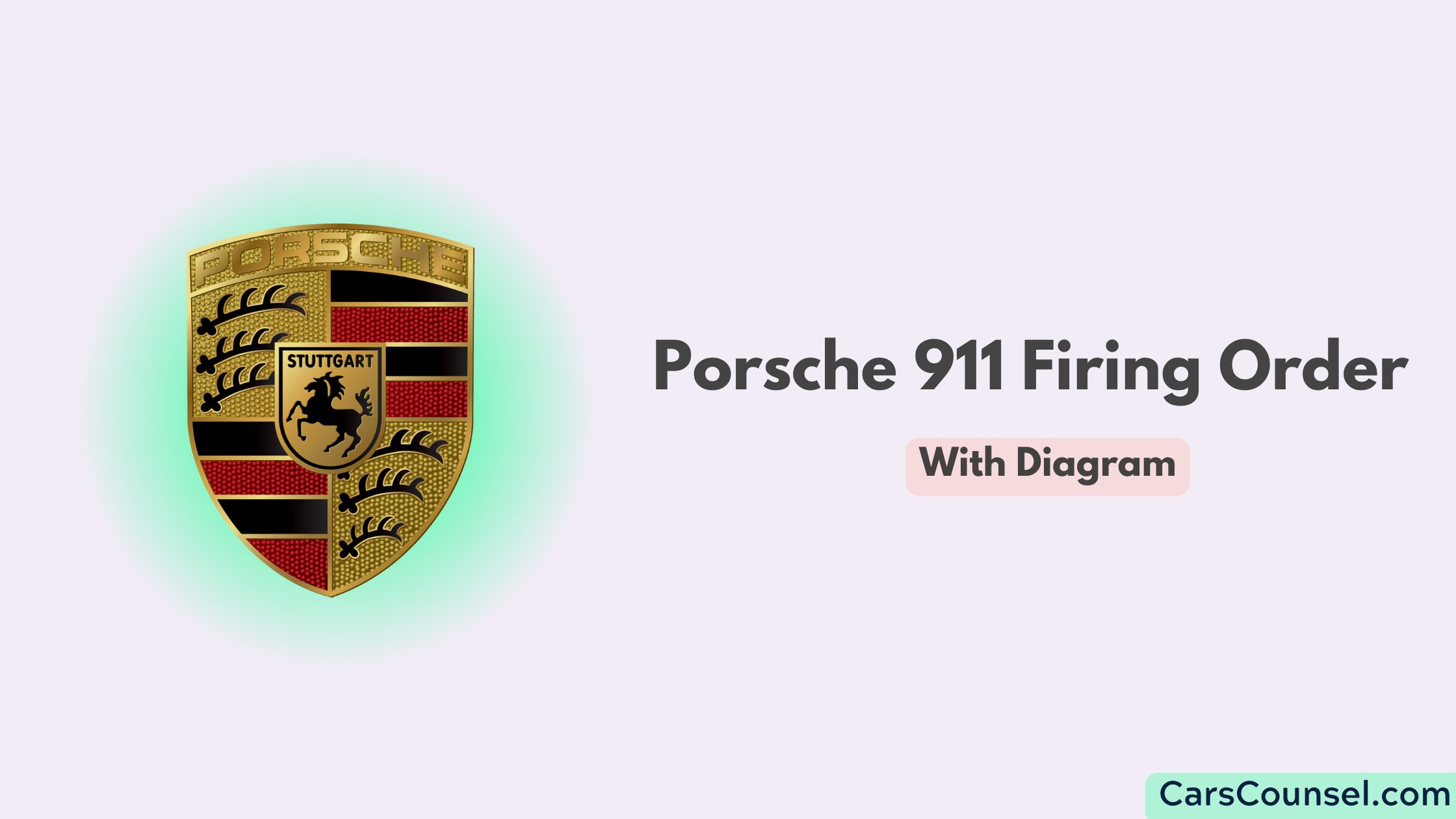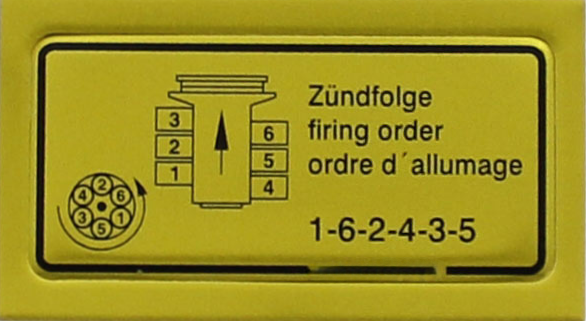The Porsche 911, with its iconic design and rear-engine layout, is one of the most recognizable sports cars in automotive history. Its horizontally opposed (flat) six-cylinder engine, known for smooth performance and exceptional balance, is the heart of this legendary vehicle.
A key aspect of the 911’s engine operation is the firing order, the sequence in which the engine’s cylinders fire to produce power.
In this guide, we’ll delve into the firing order of the Porsche 911 engine, explain its importance, and explore how it impacts performance. Whether you’re a 911 owner, a mechanic, or an enthusiast, understanding the firing order is essential for maintaining and troubleshooting this remarkable engine.

Quick Navigation
The Porsche 911 Firing Order
The firing order for the Porsche 911 flat-six engine is: 1-6-2-4-3-5

How the Firing Order Works
- Cylinder 1 Fires First: Located on the left bank, closest to the flywheel.
- Cylinder 6 Fires Second: Positioned on the right bank, furthest from the flywheel.
- Cylinder 2 Fires Third: Located on the left bank, middle position.
- Cylinder 4 Fires Fourth: Positioned on the right bank, middle position.
- Cylinder 3 Fires Fifth: Located on the left bank, furthest from the flywheel.
- Cylinder 5 Fires Sixth: Positioned on the right bank, closest to the flywheel.
This alternating sequence between the left and right banks ensures balanced combustion and smooth engine operation.
Why Porsche Uses the 1-6-2-4-3-5 Firing Order
The 1-6-2-4-3-5 firing order is optimized for the flat-six engine’s design and performance. Here’s why it works:
- Balanced Operation: Alternates firing between opposing cylinders, minimizing vibrations and promoting smoothness.
- Steady Torque Delivery: Evenly spaced combustion events ensure consistent power output.
- Efficient Cooling: The sequence allows time for heat dissipation, particularly in air-cooled models.
- Crankshaft Design Compatibility: Matches the flat-six crankshaft’s throw configuration, reducing mechanical stress.
What Is a Firing Order?
The firing order is the sequence in which an engine’s cylinders ignite their air-fuel mixture. For flat-six engines like the Porsche 911’s, the firing order is meticulously designed to ensure smooth operation and efficient power delivery. The firing sequence depends on the engine’s crankshaft configuration, camshaft design, and cylinder arrangement.
Why the Firing Order Matters
- Smooth Operation: Balances combustion forces to minimize vibrations.
- Efficient Power Delivery: Provides consistent torque and steady performance.
- Durability: Reduces mechanical stress on the crankshaft and bearings.
- Fuel Efficiency: Optimizes combustion timing for better mileage and lower emissions.
Overview of the Porsche 911 Engine
The Porsche 911 engine, first introduced in 1964, features a horizontally opposed six-cylinder layout. This flat-six engine, often referred to as a “boxer” engine, is compact, lightweight, and known for its balanced operation. Over the years, Porsche has refined this engine, incorporating modern technologies such as fuel injection and turbocharging.
Key Features of the Porsche 911 Engine
- Flat-Six Configuration: Six cylinders arranged in two banks of three, lying flat and opposing each other.
- Air-Cooled (Pre-1998): Older models used air cooling, while newer versions feature water cooling.
- Rear-Mounted Layout: Positioned behind the rear axle for unique handling characteristics.
- Cylinder Numbering:
- Left Bank: Cylinders 1, 2, 3 (driver’s side in left-hand-drive models).
- Right Bank: Cylinders 4, 5, 6 (passenger’s side in left-hand-drive models).
Identifying the Firing Order
Understanding the cylinder numbering and firing order is essential for performing maintenance or diagnosing engine issues.
Cylinder Numbering
The cylinders are numbered sequentially based on their position:
- Left Bank: Cylinders 1, 2, 3 (from front to rear).
- Right Bank: Cylinders 4, 5, 6 (from front to rear).
Distributor Orientation
In older Porsche 911 models with a distributor, the rotor aligns with each cylinder’s corresponding spark plug wire to deliver the correct firing order. On modern models with electronic ignition, the engine control unit (ECU) manages the firing sequence.
Symptoms of an Incorrect Firing Order
An incorrect firing order can disrupt engine performance and cause a variety of issues. Recognizing these symptoms can help you address problems promptly.
Common Symptoms
- Engine Misfires: Uneven combustion causes power loss and rough operation.
- Rough Idling: The engine vibrates excessively or feels unstable at idle.
- Power Loss: Reduced acceleration and performance due to disrupted combustion timing.
- Backfiring: Improper ignition timing can result in explosions in the intake or exhaust manifold.
- Increased Fuel Consumption: Inefficient combustion leads to higher fuel usage and emissions.
Diagnosing and Fixing Firing Order Problems
If you suspect issues with the firing order, follow these steps to diagnose and resolve them:
Diagnostic Steps
- Inspect Spark Plug Wires: Ensure each wire is routed to the correct cylinder based on the 1-6-2-4-3-5 firing order.
- Check the Distributor (if applicable): Verify the rotor aligns with the distributor cap terminals in the correct sequence.
- Use a Timing Light: Confirm ignition timing matches the engine’s specifications.
- Perform a Compression Test: Check each cylinder’s compression to ensure proper firing.
Fixing Common Issues
- Reconnect Spark Plug Wires: Route wires correctly to their respective cylinders.
- Replace Faulty Components: Install new spark plugs, ignition wires, or distributor caps if needed.
- Adjust Timing: Use a timing light to realign ignition timing as necessary.
Preventative Maintenance for Firing Order Reliability
Maintaining the correct firing order is essential for keeping your Porsche 911 engine running smoothly. Follow these preventative tips to avoid issues:
Regular Inspections
- Check spark plugs, ignition wires, and distributor components for wear or damage.
- Inspect timing chain or belt alignment during routine maintenance.
Replace Components as Needed
- Replace spark plugs and ignition wires according to manufacturer recommendations.
- Use high-quality, OEM parts to ensure compatibility and reliability.
Verify Timing
- Periodically inspect ignition timing using a timing light.
- Reconfirm the firing order when replacing ignition components or performing major engine repairs.
FAQs About the Porsche 911 Firing Order
Can I Change the Firing Order?
No, the firing order is fixed by the engine’s design and crankshaft configuration. Altering it would require extensive mechanical modifications.
What Happens If the Firing Order Is Incorrect?
An incorrect firing order can cause misfires, power loss, backfiring, and potential damage to the engine.
How Can I Verify the Firing Order?
Refer to the owner’s manual, inspect spark plug wire routing, and use diagnostic tools to confirm the sequence.
Is the Firing Order the Same for All Flat-Six Engines?
No, while many flat-six engines share similar firing orders, specific configurations can vary based on the manufacturer and engine design.
Engines with Similar Firing Orders
Conclusion
The 1-6-2-4-3-5 firing order is a critical component of the Porsche 911 engine, ensuring smooth performance, balanced power delivery, and efficient combustion. Understanding this sequence is essential for maintaining and troubleshooting the flat-six engine, whether you’re working on a vintage 911 or a modern variant.
By following proper maintenance practices, verifying ignition timing, and addressing issues promptly, you can keep your Porsche 911 running at its best. Whether you’re a seasoned mechanic or an enthusiastic owner, mastering the firing order is a vital step in preserving the legacy of this iconic sports car.

